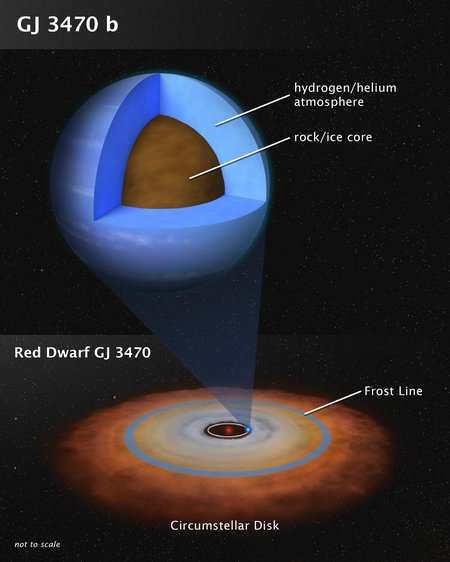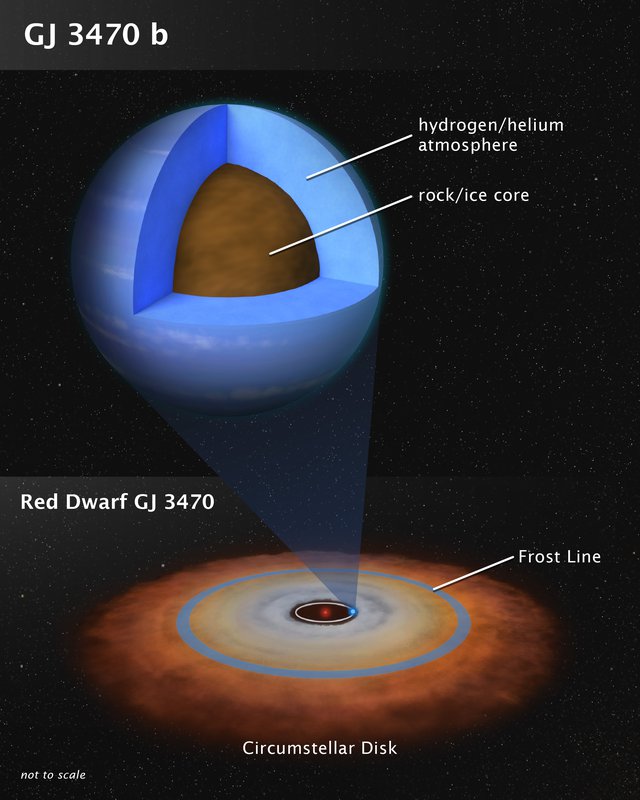For the first time, a team of researchers has probed the chemical composition of the atmosphere of a new class of exoplanet. The team, led by Université de Montréal astronomy professor Björn Benneke, included Caltech planetary scientist Heather Knutson.
The planet, dubbed GJ 3470 b, is unlike anything found in our solar system and resembles a cross between Earth and Neptune, with a large rocky core buried under a deep, crushing hydrogen and helium atmosphere. Its mass is 12.6 times that of Earth, but somewhat less than that of Neptune, which weighs in at 17 Earth masses. An analysis of the new planet was published in Nature Astronomy on July 1.
Many similarly sized worlds have been discovered by NASA's Kepler space telescope. In fact, 80 percent of the planets in our galaxy fall into this mass and size range, but astronomers have never been able to understand the chemical nature of the atmosphere of such a planet until now. Astronomers enlisted the combined multi-wavelength capabilities of NASA's Hubble and Spitzer space telescopes to do a first-of-its-kind probe of GJ 3470 b's atmosphere.
"We expected to find an atmosphere strongly enriched in heavier elements like oxygen and carbon that create abundant water vapor and methane gas," says Benneke, who worked as a postdoctoral researcher at Caltech during much of this project and is the lead author of the Nature Astronomy paper. "Instead, we found an atmosphere that is so poor in heavy elements that its composition resembles the hydrogen- and helium-rich composition of the sun."
Caltech's Knutson advised Benneke on this project and provided a second data set used to detect molecular features in light emitted from the planet's day side. "We understand the planet better when we observe its atmosphere using more than one technique; this is particularly true for planets with high-altitude clouds, which usually only affect select regions of the atmosphere," says Knutson.
Read the full story from the Space Telescope Science Institute here.
 This artist's illustration shows the theoretical internal structure of the exoplanet GJ 3470 b. It is unlike any planet found in the Solar System. Weighing in at 12.6 Earth masses the planet is more massive than Earth but less massive than Neptune. Unlike Neptune, which is 3 billion miles from the Sun, GJ 3470 b may have formed very close to its red dwarf star as a dry, rocky object. It then gravitationally pulled in hydrogen and helium gas from a circumstellar disk to build up a thick atmosphere. The disk dissipated many billions of years ago, and the planet stopped growing. The bottom illustration shows the disk as the system may have looked long ago. Observations by NASA's Hubble and Spitzer space telescopes have chemically analyzed the composition of GJ 3470 b's very clear and deep atmosphere, yielding clues to the planet's origin. Many planets of this mass exist in our galaxy.
Credit: NASA, ESA, and L. Hustak
This artist's illustration shows the theoretical internal structure of the exoplanet GJ 3470 b. It is unlike any planet found in the Solar System. Weighing in at 12.6 Earth masses the planet is more massive than Earth but less massive than Neptune. Unlike Neptune, which is 3 billion miles from the Sun, GJ 3470 b may have formed very close to its red dwarf star as a dry, rocky object. It then gravitationally pulled in hydrogen and helium gas from a circumstellar disk to build up a thick atmosphere. The disk dissipated many billions of years ago, and the planet stopped growing. The bottom illustration shows the disk as the system may have looked long ago. Observations by NASA's Hubble and Spitzer space telescopes have chemically analyzed the composition of GJ 3470 b's very clear and deep atmosphere, yielding clues to the planet's origin. Many planets of this mass exist in our galaxy.
Credit: NASA, ESA, and L. Hustak

